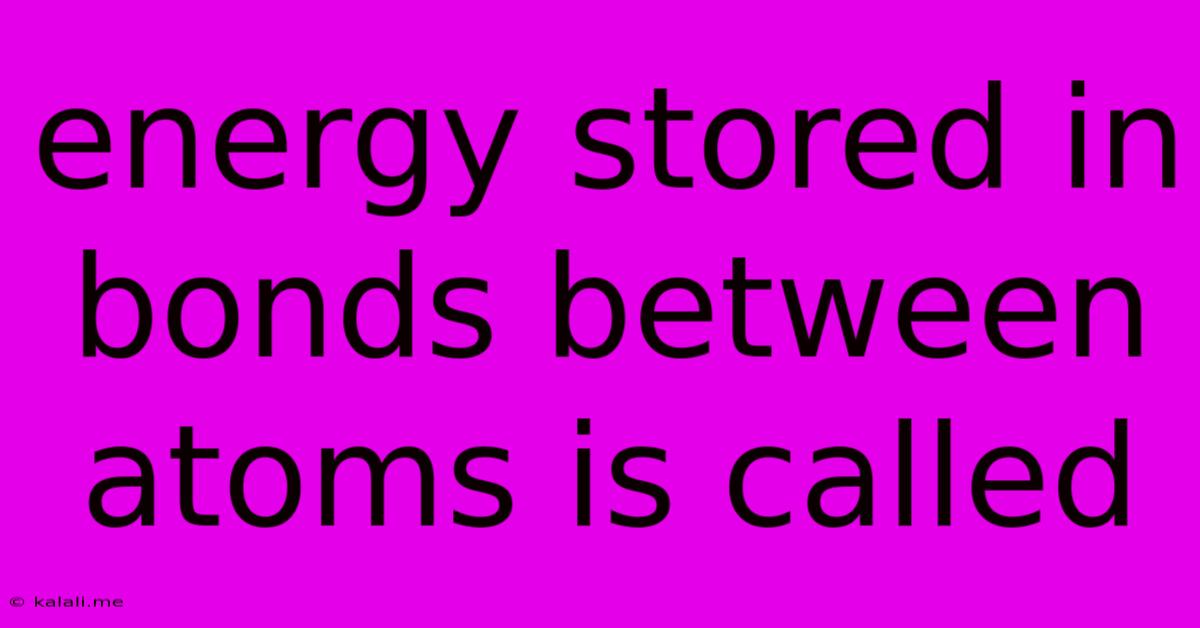Energy Stored In Bonds Between Atoms Is Called
Kalali
Jun 14, 2025 · 3 min read

Table of Contents
Energy Stored in Bonds Between Atoms is Called Chemical Energy
The energy stored in the bonds between atoms is called chemical energy. This energy is a form of potential energy, meaning it's stored energy that has the potential to be released and converted into other forms of energy, such as heat, light, or mechanical energy. Understanding chemical energy is crucial in various fields, from chemistry and physics to biology and engineering. This article will delve into the intricacies of chemical energy, exploring its sources, release mechanisms, and applications.
Chemical bonds, the forces that hold atoms together in molecules and compounds, are the key to understanding chemical energy. These bonds are formed by the interactions of electrons, the negatively charged particles orbiting the nucleus of an atom. The stronger the bond, the more energy is required to break it, and subsequently, the more energy is released when the bond is formed. Different types of chemical bonds—ionic, covalent, and metallic—store varying amounts of chemical energy.
Types of Chemical Bonds and Energy Storage
-
Covalent bonds: These bonds involve the sharing of electrons between atoms. Examples include the bonds in organic molecules like carbohydrates, lipids, and proteins, which are crucial energy sources for living organisms. The energy stored in these bonds is released during metabolic processes like respiration and digestion.
-
Ionic bonds: These bonds form through the electrostatic attraction between oppositely charged ions. The energy stored in these bonds is often released as heat when ionic compounds dissolve in water or undergo reactions. Table salt (sodium chloride) is a prime example of a compound with ionic bonds.
-
Metallic bonds: These bonds involve the sharing of electrons among a "sea" of delocalized electrons within a metal structure. The energy stored in metallic bonds contributes to the properties of metals, such as their malleability and conductivity.
How Chemical Energy is Released
Chemical energy is released through chemical reactions. These reactions involve the breaking and forming of chemical bonds. When bonds are broken, energy is absorbed; when bonds are formed, energy is released. The net energy change determines whether a reaction is exothermic (releases energy) or endothermic (absorbs energy). Exothermic reactions are the primary source of energy for many processes, including combustion and cellular respiration.
Examples of the release of chemical energy include:
-
Combustion: Burning fuel, such as wood or gasoline, releases chemical energy in the form of heat and light. This process involves the rapid oxidation of fuel molecules, breaking and reforming chemical bonds.
-
Cellular Respiration: Living organisms release chemical energy stored in glucose and other food molecules through a series of controlled chemical reactions. This energy is used to power cellular processes.
-
Explosions: Explosions involve the extremely rapid release of chemical energy, often resulting in a significant expansion of volume and the generation of shock waves.
Applications of Chemical Energy
The applications of chemical energy are vast and far-reaching. From powering vehicles to generating electricity to fueling biological processes, it underpins countless aspects of modern life.
-
Fuel Sources: Fossil fuels (coal, oil, and natural gas) are rich sources of chemical energy derived from ancient organic matter. They are widely used for transportation, electricity generation, and heating.
-
Batteries: Batteries store chemical energy and convert it into electrical energy through electrochemical reactions. This is crucial for portable electronic devices and electric vehicles.
-
Biofuels: Biofuels, derived from biomass, represent a renewable source of chemical energy. They are gaining increasing importance as a more sustainable alternative to fossil fuels.
In conclusion, chemical energy, the energy stored within the bonds connecting atoms, is a fundamental concept in science and technology. Understanding how this energy is stored, released, and utilized is essential for addressing various challenges in energy production, environmental sustainability, and technological advancement. The versatility of chemical energy and its role in powering life and technology make it a continuously relevant and fascinating area of study.
Latest Posts
Latest Posts
-
What Is The Measure Of Angle 6
Jun 15, 2025
-
The Mass Per Unit Volume Of A Substance Is Called
Jun 15, 2025
-
What Is The Opposite Of Dangerous
Jun 15, 2025
-
Which Of The Following Is A Mechanical Wave
Jun 15, 2025
-
Is Dcm More Dense Than Water
Jun 15, 2025
Related Post
Thank you for visiting our website which covers about Energy Stored In Bonds Between Atoms Is Called . We hope the information provided has been useful to you. Feel free to contact us if you have any questions or need further assistance. See you next time and don't miss to bookmark.